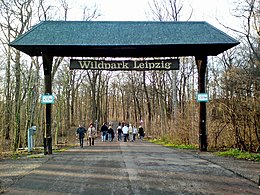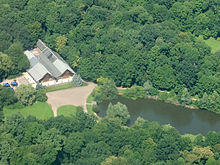Leipzig Wildlife Park
The Leipzig Wildlife Park is an animal park on the southern outskirts of Leipzig in the Connewitz district . It is located in the Leipzig floodplain forest and is 42 hectares in size.
In the Leipzig Wildlife Park, around 25 animal species with around 250 animals that live or have lived in Central Europe or that have made their home here are shown free of charge. Red deer , fallow deer and mouflon have a common large enclosure. There are also extensive enclosures for deer , wild boar , elk and bison . Lynx , otters , wild cats , raccoons , mink , red fox and the European mink are kept in open enclosures.
An exhibition room is available for the presentation of exhibitions and events. On a special adventure trail, visitors to the wildlife park have the opportunity to observe game without barriers. The tea house , which is housed in a Russian log cabin , the wildlife park restaurant and a snack bar provide catering within the park . There are two playgrounds on the wildlife park area : the Märchenburg forest playground at the main entrance to Koburger Strasse and the fairytale playground behind the Russian tea house.
A kiln with an open fireplace can be rented for private parties.
The Jungfernlache and Panichs Lache , two oxbow lakes from Pleiße and Weißer Elster in their common floodplain, are located on the grounds of the wildlife park .
history
In 1904 the town council received four fallow deer from the mill owner Jacob from Connewitz, for which a game gate was set up in the stamp district. Because of frequent flooding, the choice of location turned out to be unsuitable. In 1906 an area around the Heidaer meadows was fenced in and the animal population, which had grown in the meantime, was moved. In 1912 a refuge was opened, which was connected to the serving of milk, tea, mineral water and baked goods, before a wildlife park restaurant was built in 1922 in the area of today's farmyard.
In the 1930s, the City Council of Leipzig provided the Reich Central Office for Fur Animal and Tobacco Research with a neighboring area for a silver fox experimental farm . They promised an additional attraction for the so-called deer park. The proximity to a local recreation area turned out to be a disadvantage, however, as the many day trippers constantly worried the animals. In Dölitz , the university's veterinary faculty later set up its own research institute.
The Second World War ended the development of the wildlife park and brought its complete destruction, including the restaurant. At the end of the war, the enclosures were opened to protect the animals from attacks.
It was not until 1972 that the Leipzig city council decided to create a new wildlife park in the area of the former animal enclosure. Construction began on January 1, 1974, and in October 1979 the entire facility with its current dimensions was handed over. Also in 1974 the construction of a new wildlife park restaurant, now at the Hakenteich, began.
Web links
- The wildlife park on the website of the city of Leipzig
- Website of the Association of Friends and Patrons of Wildlife Park Leipzig e. V.
Individual evidence
- ^ Walter Fellmann: The Leipziger Brühl . VEB Fachbuchverlag, Leipzig 1989, p. 132.
Coordinates: 51 ° 17 ′ 52 ″ N , 12 ° 21 ′ 58 ″ E








